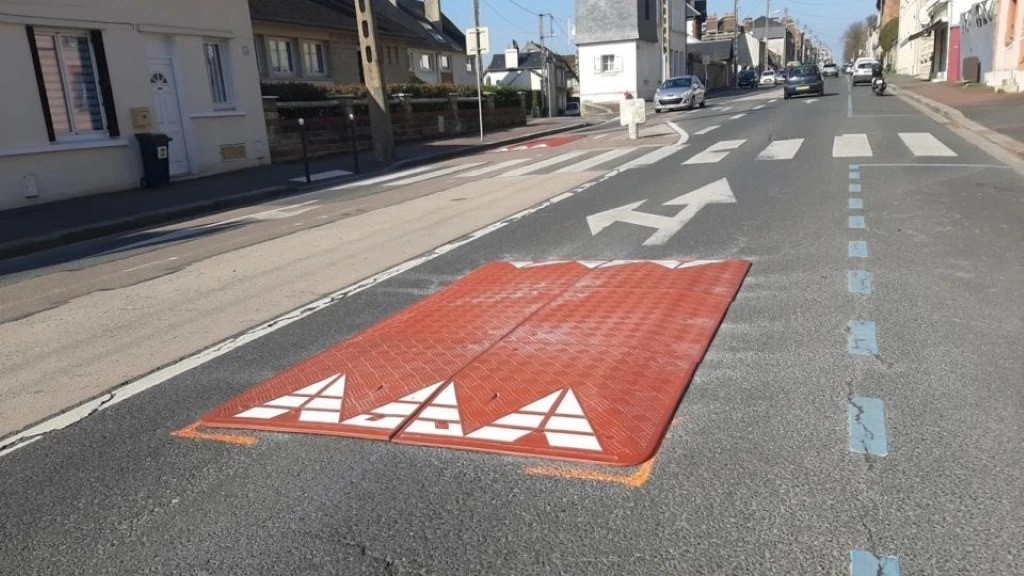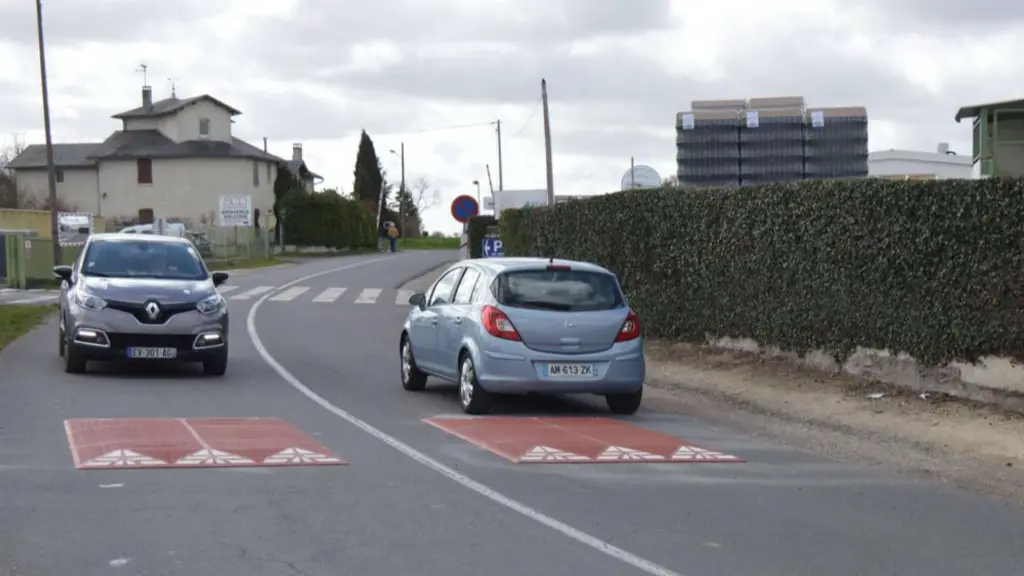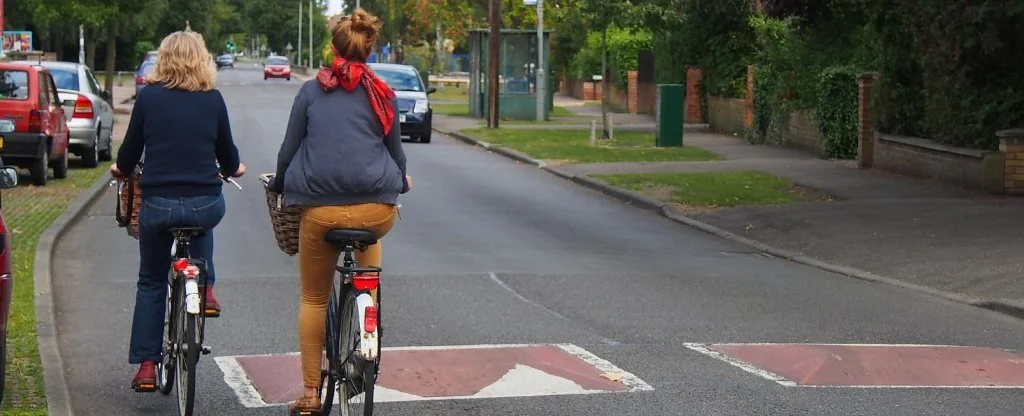How does a Speed Cushion work?
Traffic control devices are used on roads, city streets, and parking lots to regulate traffic and make people follow traffic safety rules. They come in different patterns or forms, and you can install them anywhere on roadways, so they are visible to street or road users.
There are different types of traffic control devices. Some include speed bumps, speed humps, speed cushions, parking signs, traffic cones, bollards, and warning signs. Each device plays a different role and works in a certain way.
Here, you will learn how exactly a speed cushion works and the correct way to use it.

Discover here our full range of Speed Cushions!
What is a speed cushion?
A speed cushion is a traffic safety device that acts as an obstruction on the road. Its surface is raised and generally installed in the center of a traffic lane. Its width is smaller than that of long-axle vehicles such as ambulances, fire trucks, and buses, but it is more than the width of cars.
This unique design allows this tool to slow down cars without affecting the speed of emergency vehicles, bicyclists, and cyclists. It makes them a suitable alternative to speed bumps, speed humps, and speed breakers on emergency vehicle routes.
You can use speed cushions in pairs or groups depending on the width of the road and your speed control needs.
People call speed cushions by different names. Some of their other popular names are speed tables, speed lumps, and road cushions.

How do speed cushions work?
The raised section of a speed cushion acts as an obstacle. A driver must reduce his vehicle’s acceleration to drive over the speed cushion without trouble.
However, when a long-axle vehicle drives over the speed cushion, its wheels pass through the spacing between two speed cushions, reducing the need for drivers to bring their speed down.
A cyclist or bicyclist can also drive through the wheel cutout to avoid a speed cushion and speed reduction.
What is the road cushion’s impact on speed reduction?
A speed cushion can force car drivers to reduce their speed from 15 to 20 miles per hour (mph).
If they drive over this traffic-management tool without slowing down, they may experience a sudden jolt or a slight jump which can damage internal parts of their vehicle and cause discomfort to passengers.
The Federal Highway Administration and the Transportation Department install speed cushions in traffic lanes, intersections, traffic circles, pedestrian crossings, complete streets, and residential areas where drivers should keep the speed limit low to prevent accidents and fatalities.

What is the best way to drive over a speed cushion?
The best and safest way to drive over a speed cushion is to reduce your vehicle’s speed up to 20 mph before you reach the speed cushion. This way, you will not experience any sudden jump, and no unwanted sound will be produced.
Municipalities should use speed signs, pavement markings, or speed limit signs to inform drivers about the presence of speed cushions beforehand. It will give drivers enough time to reduce their speed before they reach a speed cushion.
Speed cushions are available in different materials, such as recycled rubber, recycled plastic, and concrete. Since concrete and plastic are non-flexible materials, their impact on the vehicle will be high. In contrast, rubber is a flexible and tough material, so rubber speed cushions produce the least impact on your vehicle.
Get in touch
The Speed Cushions Factory is a leading manufacturer of rubber speed cushions located in Qingdao, China.
Feel free to contact us!
We are always here to help!
Qingdao, Shandong Province, China.
sales@speed-cushion.com
Can you park on a speed lump?
It is possible to park on a speed table, but it is not recommended as it is not the ideal place to park a vehicle.
Public and street parking areas are the suitable spaces you should use to park your vehicles whenever you want to securely.
Police vehicles, ambulances, or emergency vehicle drivers may park these vehicles on speed tables in certain situations. However, a standard car driver should avoid doing so.
How do speed cushions make roads and streets safe for people?
All the traffic calming measures, including traffic barriers, city traffic signs, speed breakers, wheel stops, road bumps, rumble strips, and speed cushions, are very effective in controlling traffic volume and managing traffic flow to make roads safe for all.
If you analyze speed cushions, here is how they make roads safe and better.
- They slow down speeding vehicles in a slow zone, reducing their chance of colliding with other vehicles or pedestrians.
- They offer school students or office workers protection when installed around a school or work zone.
- They help in diverting drivers to alternate paths. It is a common practice among drivers to avoid routes that have highway safety or pedestrian safety tools. So, when you install speed cushions on a busy road, drivers will most likely change their route to avoid the tool, helping you make a busy road less hectic.
- The gap between the two speed cushions allows stormwater to move easily. This way, it does not accumulate on roads after a storm and reaches drainage easily.
- Speed cushions do not slow down emergency vehicles. So they reach their destination on time and help save lives without unwanted delays.
- Transportation engineers can install speed cushions in many different places, such as roundabouts, cut-throughs, pedestrian zones, interchanges, or crosswalks, to impose speed limit regulations on drivers. It makes speed cushions versatile.
- They promote secure driving habits among drivers.

Can speed cushions be dangerous?
Speed cushions are constructed according to the rules and regulations issued by local committees and municipalities. Their dimensions, designs, and materials are chosen after considering public safety and standard vehicular size.
They also produce the least impact on motor vehicles compared to other traffic calming techniques like speed bumps and speed humps.
Additionally, they produce the least traffic noise. Some speed cushions have reflective tape that enhances their visibility at night. They become prominent to drivers when traffic lights reflect on them.
All these points show that speed cushions are non-dangerous for pedestrians and vehicular traffic. If drivers in your area drive rashly and do not follow the speed limit, you should request your local municipality to install these beneficial tools in your neighborhood. It will certainly help you make your area safe.
Conclusion
Speed cushions are raised obstructions fixed on the flat surface of roads to slow down speeding cars without affecting the speed of emergency vehicles. You can use them to impose speed limits on car drivers.
The good thing about this tool is it does not block free rainwater movement, hence; water reaches drainage easily. It also does not decrease the response time of emergency vehicles that some other tools do.
If the number of accidents due to over-speeding increases in your area, you should consider buying and installing rubber speed cushions. They will promote safe driving, reduce accident frequency and protect precious lives on roads.
Check your local rules and regulations regarding speed cushions to ensure you choose a product that goes well with these rules.
Get in touch
The Speed Cushions Factory is a leading manufacturer of rubber speed cushions located in Qingdao, China.
Feel free to contact us!
We are always here to help!
Qingdao, Shandong Province, China.
sales@speed-cushion.com
You might be interested in the below articles:
- What are the Most Famous Traffic Calming Devices?
- How Far apart should Speed Cushions be Installed?
- How to Install a Speed Cushion?
- Top 5 Speed Cushions Brands!
- What are the Dimensions of a Speed Cushion?
- Speed Bumps, Humps, Tables, Cushions – What’s the difference?
- Speed Cushions vs. Speed Bumps, Humps, and Tables
- Speed Cushions in Different American Cities
- What are Speed Cushions Regulations?
- Top 8 Frequently Asked Questions about Speed Cushions